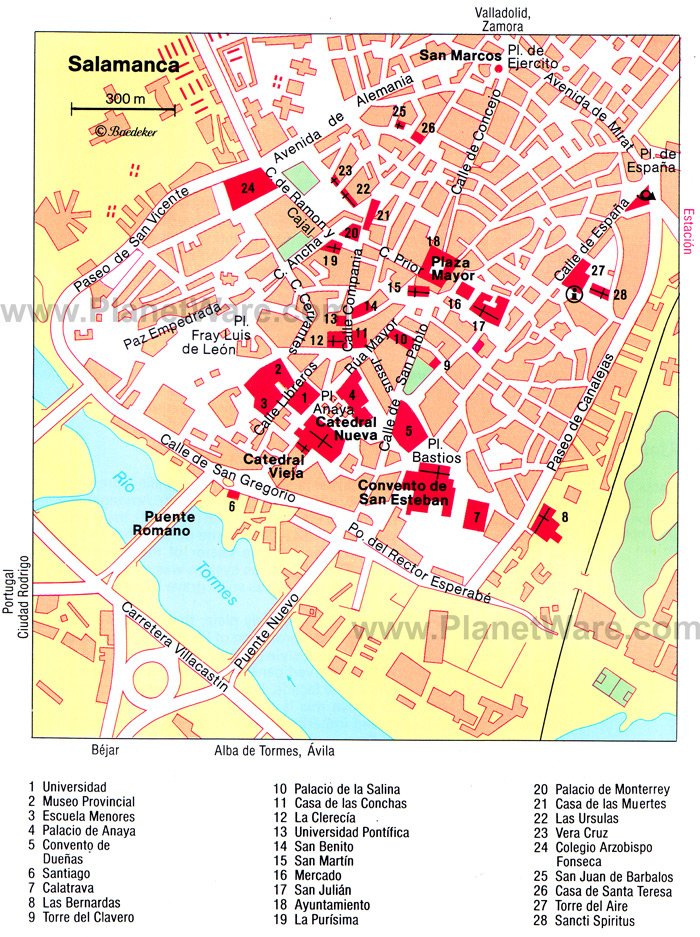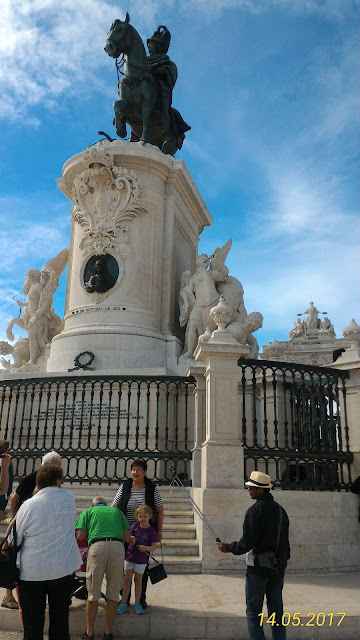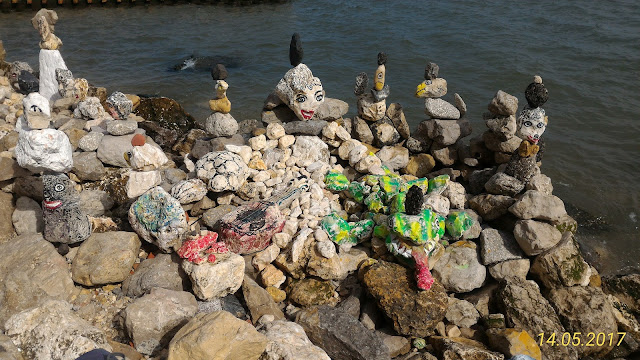15 MAY 2017.DAY 9 : MOROCCO,SPAIN,PORTUGAL TRIP.
This is screenshot of Map of Day 9 of our Morocco,Spain,Portugal Trip
Places of attractions of Salamanca City.
Screen shot of map, above, gives limited information. On the other hand "Interactive Map" gives much
more information. For interactive map GO HERE
OR go to link :https://goo.gl/2JWn6g
With this URL,Interactive map should open in a new window
To navigate through this map use the left vertical panel on the map :
1. The size of this map can be increased or decreased as with normal maps.
2. The panel gives contents of the map which are self explanatory.Placing the cursor on any item,say Mayor Square,in this panel mayor square will be highlighted by a white circle.in the interactive map.Go to Mayor Square,Zoom if you want to see details of Mayor Square.
3. Click on Mayor square in panel it will open an information window in the interactive map giving information about Mayor square.Up to 10 phptps can be loaded about that place in this information panel. Photos about that place have been uploaded in this information panel.To know about the captions and other details of photos, you will have to visit album for day 9(You will have to see all the photos of that day.)For this go here
or copy paste this link in URLaddress bar : https://goo.gl/TBPMcL
4. Similar action can be repeated for information on all other places given on interactive map.
15 MAY2017, DAY 9
From our hotel O Hotel Golf Mar we Started early in morning,around 0745,for our next destination Salamanca,
Distance from O Hotel Golf Mar to Salamanca is about 460 KMs.We did not go directly to the Hotel Horus, where we were to stay.
On the way, First we stopped for restroom break at Truck Stop Service area.Took some photos.
Second stop was immediately after crossing the Portugal Spain border at village Funtes de Onoro.We had Rest Room as well as Coffee break here.It was a nice,serene and clean place.Some nice photos.l
From here proceeded to Salamanca .
SALAMANCA

Map Courtesy Planetware.com.
Located in the western part of Spain,right besides the border with Portugal,Salamanca is medium sized city of with a population of about 1.7 lacks.Salamanca is about 200 KMs East of capital Madrid.
This ancient university town was first conquered by the Carthaginians in the 3rd century B.C. It then became a Roman settlement before being ruled by the Moors until the 11th century. The university, one of the oldest in Europe, reached its high point during Salamanca's golden age. The city's historic centre has important Romanesque, Gothic, Moorish, Renaissance and Baroque monuments. The Plaza Mayor, with its galleries and arcades, is particularly impressive.
Salamanca has been declared World Heritage City by the UNESCO.It was chosen as European City of Culture in 2002.
Salamanca had become famous due to Salamanca University which had reached its zenith during Golden age of Spain,(early 16th century to late 17th century.) With the crowds of Young people to be seen throughout the city, even today one gets the impression that even today Salamanca University is the life and soul of the city.
The coach dropped us near a palace where we were supposed to have lunch.Which also happened to be close to first attraction we were to visit namely Plaza Mayor.Other attractions seen by us in a sequence were first Plaza Mayor,Salamanca University,New Cathedral and Old cathedral.All are in old city and within walking distance.Salamancs has to 28 attractions on offer.Most of the sites recommend or gives list of around 10 attractions.We saw only four of the best of 10,mentioned above.Most of them only from outside :(
PLAZA MAYOR.

Plaza Mayor.
Photo courtesy Planetware.
Photo courtesy Planetware.
Plaza Mayor in Salamanca has nothing to do with the high ranking official of a Municipality.
In Portuguese Plaza means Square and Mayor means Greater or Great.So Plaza Mayor simply means Great Square.The buildings were built in the traditional Spanish baroque style.Work was begun in 1729 based on the designs of Alberto de Churriguera and completed in 1755.
In Portuguese Plaza means Square and Mayor means Greater or Great.So Plaza Mayor simply means Great Square.The buildings were built in the traditional Spanish baroque style.Work was begun in 1729 based on the designs of Alberto de Churriguera and completed in 1755.
The Plaza Mayor (Main Plaza) is a beautiful large plaza or public square located in the heart of Salamanca.It is considered one of the grandest plazas in Spain.The size of square is 129 m × 94 m (423 ft × 308 ft).It is surrounded by a arcades three-story buildings in which have uniform architectural style.The colonnade supporting the upper stories of buildings and is surrounded by 88 arches,has 89 commemorative medallions dedicated to distinguished people, 247 balconies, 96 obelisks.Among the monumental buildings on this square are the Pabellón Real(Royal Pavilion) and the Churriguera-style Ayuntamiento
It was built in the traditional Spanish baroque style.Plaza Mayor has served as a setting for ceremonial occasions as well as bullfights until the 19th century.Now it is most favoured gathering for the old and new generation of Salamanca.
Now it is lined by restaurants, ice cream parlours, tourist shops, jewelry stores and a pharmacy along its perimeter except in front of the city hall.It is connected to the shopping area Calle del Toro from the northeast, Calle de Zamora from the north, the restaurants on Calle de Concejo from the northwest, Calle del Prior and the small Calle de la Caja de Ahorros from the west as well as Plaza del Corrillo from the south.
The present generation of administrators are tying to bled modern sculptures and statues with the traditional Spanish baroque style.Example was an upside elephant standing on its trunk . Work on that project was still going on when we visited.
Some more photos below.
To see all the photos of day 9 GO HERE.

Traditional baroque style , now time for modern statues / monuments.
One of the Six entrances of the plaza.
Traditional baroque style , now time for modern statues / monuments.
Often a RV point with Among the locals,common saying"see you under the bell "

Notice the commemorative medallions dedicated to distinguished people between the arches.There are total of 89 of them around the square.
Notice the commemorative medallions dedicated to distinguished people between the arches.There are total of 89 of them around the square.
There are total of 89 of them around the square.
After looking around and having a grand photo session we proceeded to next attraction,University Of Salamanca.
UNIVERSITY OF SALAMANCA.

In case photo disappearslink :nhttps://goo.gl/GQFNHm
Photo courtesy wiki,by author Valyag.
In the historic center of town is the world-famous Salamanca University, founded in 1218 as the first university in Spain and modeled after the University of Bologna in Italy. Salamanca University became one of the most important centers of learning in Europe during the Middle Ages. It recognized the Copernican system (the concept that the sun is the center of the universe) at a time when the church still regarded this idea as heresy. Miguel de Cervantes, Spain's most well-known writer and author of the novel Don Quixote, was a student of the university. The buildings of the Escuelas Mayores, built between 1415 and 1433, represent the university proper. Designed around the central courtyard of the Patio de Escuelas, the most interesting feature of these buildings is the elaborately decorated facade. The original building was relatively plain. In 1534, it was enhanced with its lavish profusion of Plateresque ornamentation and is an unsurpassed masterpiece of that fanciful architectural style.

Main entrance of Salamnca University.
Salamanca University is a Spanish higher education institution. It was founded in 1134 and given the Royal charter of foundation by King Alfonso IX in 1218.It was first university in Spain and modeled after the University of Bologna in Italy. It is the oldest founded university in Spain and the third oldest university in the world in continuous operations.
It was at zenith of its fame and achieved unparalled heights in academics and learning iduring the golden age of Spain.Salamanca University became one of the most important centers of learning in Europe during the Middle Ages. It recognized the Copernican system (the concept that the sun is the center of the universe) at a time when the church still regarded this idea as heresy. Miguel de Cervantes, Spain's most well-known writer and author of the novel Don Quixote, was a student of the university. The buildings of the Escuelas Mayores(English:Major Schools),University main building,was built between 1415 and 1433.Designed around the central courtyard of the Patio de EscuelasYard of the Schools) a square with the statue of Luis de León,most interesting feature of these buildings is the elaborately decorated facade. The original building was relatively plain. In 1534, it was enhanced with its lavish profusion of Plateresque ornamentation and is an unsurpassed masterpiece of that fanciful architectural style.
Main entrance Salamanca University.Extensive and fantistic engravings.
While doing research,I found detailes about these engraved panels.What I found is given below.However to check them you will have to go this photo in the album(for album GO HERE.) and zoom.
Finely carved panels separated by pilasters are above two entrance doorways.In the center at the first level is a medallion featuring likenesses of the Catholic Monarchs.Further up are the coat of arms of Charles V, flanked by the double-headed imperial eagle and the eagle of Saint John; above this is the Pope surrounded by cardinals, with figures of Venus, Priam, and Bacchus to the right and Hercules, Juno, and Jupiter to the left.
Engravings on piller on right of double doors.
Look for the figure considered to bring good luck,
Answer at the end of the para.
Some more photos below.
Statue of Luis de León at "The Patio de Escuelas"(Yard of the Schools).
facing Double doors of Salamanc University(Main School)
Photo courtesy Wiki.Author:Tamorlan.
My Photo of "The Patio de Escuelas".Statue of Luis de León
University Double doors behind me.
Beautiful engraving on side panel on the monument to Luis de León.
Entry gate to The Minor schools of the University of Salamanca.
located in the "The Patio de Escuelas"
Red writing,supposed to be in blood of bulls,killed in bull fight.
Courtyard of The Minor Schools of the University of Salamanca.Today modern sculptures adorn this courtyard surrounded by traditional old style buildings.
After this we were taken to see the New Cathedral of Salamanca.

NEW CATHEDRAL OF SLAMANCA.
Facade of the Puerta de Ramos of the New Cathedral from the Plaza de Anaya
Photo Courtesy Wiki.Author:(I presume) Página web oficial: www.catedralsalamanca.org

West gate façade of New Salamanca Cathedral, facing Plaza Juan XXIII
Taken by me.


Taken by me.
There are two cathedrals in Salamanca,both UNESCO world heritage sites. One is "Old Cathedral" and the other,obviously"New Cathedral".
All the sghts we saw today,Plaza mayor,University of Salamanca,Old Cathedral and New Cathedral are co located in close proximity.So much so that one of the walls is common between Plaza Mayor and University of Salamanca.Old Cathedral and New Cathedral share a common wall.Main gate of Old Cathedral faces East where as that of New Cathedral faces North.Our path took us along the West wall of Old Cathedral facing We did all the sights by walking through labyrinth of narrow streets.
While doing research to write about New Cathedral,I realised that there is not a single photo of Old Cathedral.The reason I found was that we never did see Old Cathedral. The reason is, I feel that while on the way to New Cathedral,along Cardenal Pla and Deniel Street, we passed through Plaza Juan XXIII with a statue of Statue of Padre Camara.I took a photo of the statue.In front of the statue is the Western, that is, the rear wall of Old Cathedral. Thus we totally by Passed the Old Cathedral.There is no photo also no information about it.
It was rather long explanation but was necessary to explain our total absence of any Old Cathedral photo.If you have a look at satellite version of google map you will readily understant what I mean
Back to our description;
New Cathedral was constructed between the 16th and 18th centuries.Because it took two centuries to complete, the building displays a combination of Gothic,Plateresque and Baroque architectural elements. The cathedral was consecrated in 1733. It was commissioned by Ferdinand V of Castile of Spain. It was declared a national monument by royal decree in 1887.
The Plateresque doorways are richly decorated, especially the west doorway and the north doorway, which features a relief of Christ's entry into Jerusalem. The 110-meter-high tower has a beautiful dome. in two styles: late Gothic and Baroque.impressive dimensions of 104 meters in length and 48 meters in width give the interior an overwhelming effect of spaciousness. The domed sanctuary soars to a height of 38 meters. The Baroque choir features an image of the Virgen de Loreto(Virgin of Loreto) . Various chapels display masterpieces of art. In the Capilla Dorada(Golden Chapel) there is tomb of Saint Ánchez de Palenzuela.In Capilla del Mariscal( Chapel of Marshal) there is figure the Virgen de la Cueva(virgin of the cave), patroness of Salamanca, in the . In the Capilla del Cristo de las Batallas(Chaple of Chtist of Battles) is an 11th-century crucifix presented by the Cid to his comrade in arms Jerónimo, later Bishop of Salamanca. Open daily for an admission fee; guided tours are available. Tourists arrive here by taking a narrow old street that runs from the university buildings; the cathedral's tower can be seen from the Patio de Escuelas.
We did not enter the Cathedral for more that a few feet.Beyound which the care taker would not let us go.Took whatever photos from that position.
Some more photos of New Cathedra.To see all the photos go to album for day 9 of trip GO HERE.

Beautifully engraved West gate façade of New Salamanca Cathedral, facing Plaza Juan XXIII
Statue of Padre Camara .Across the street from the West gate of New Cathedral.


Gate on the Facade of the Puerta de Ramos(door from Ramos)from the Plaza de Anaya.
See the wiki photo above.
Detail of pillar on the facade of the New Cathedral of Salamanca: faun with ice cream. Added during renovations in 1992.

Detail of pillar on the facade of the New Cathedral of Salamanca:Astronaut sculpture, added during renovations in 1992.
By this time it was almost 1900.We began long walk through the ancient buildings and plazas of Salamanca to the RV point where our coach was to pick us up to take us to the Hotel.
Took some nice photos enroute.Two good piactuers were taken while waiting for the coach to arrive. Later found that the glass building was Casa Lis Museo de Art Nouveau y Art Déco.It is a museum of decorative arts, with exhibits dating from the last decades of the 19th century to World War II.
Last photo taken at Salamanca was the noght view of University and Cathedral of Salamanca,taken from from City Keys Circle

Night view of University and Cathedral of Salamanca, Seen from City Keys
Cilcle.Near hotel Horus.
END DAY 9
Text courtesy wiki,planetworld and other open souece web sites.Heavely edited by me.
























